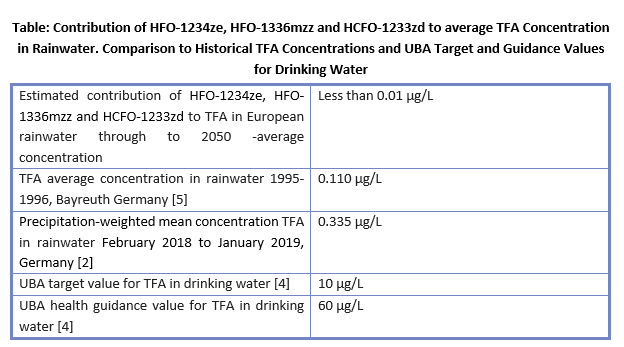CONTRIBUTION OF HFO-1234ze, HFO-1336mzz AND HCFO-1233zd TO TFA CONCENTRATION IN EUROPEAN RAINWATER EXTREMELY SMALL
The EFCTC position paper Published evidence supports very low yield of TFA from most HFOs and HCFOs [1] concluded that the very low yields of TFA from HFO-1234ze, HFO-1336mzz and HCFO-1233zd mean that their expected contribution to TFA in the environment is extremely small.
The UBA report [2] acknowledges that the contribution of these substances to TFA generation from EU emissions is minor. In fact, the very low yields of TFA from these substances (0-2% for HFO-1234ze and HCFO-1233zd, 0-4% for HFO-1336mzzZ) means that their contribution to TFA generation represents up to about 0.5% of the contribution to TFA generation from all emissions of HFCs, HCFOs, and HFOs based on the scenario of maximum future use and emissions of halogenated substitutes forecasts in the UBA report.
 Extensive studies have been undertaken to measure and forecast the concentration of TFA in rainwater due to fluorocarbon refrigerants. Based on updated low yields of TFA from HFO-1234ze, HFO-1336mzz and HCFO-1233zd [1], the scenario of maximum future use and emissions of halogenated substitutes forecasts and the same atmospheric model estimates [3] as in the UBA report on Persistent degradation products of halogenated refrigerants [2], HFO-1234ze, HFO-1336mzz and HCFO-1233zd are broadly estimated to contribute less than 0.01 µg/L to the average concentration of TFA in European rainwater through to 2050. This can be compared to historical and current rainwater concentrations, and the German drinking water guidance value of 60 µg/L [4] and is effectively negligible. While, a complete atmospheric model for Europe would be required to provide a more accurate assessment (for more details see the recent EFCTC position paper Published evidence supports very low yield of TFA from most HFOs and HCFOs [1]) the conclusion of very low contribution to TFA in the environment from HFO-1234ze, HFO-1336mzz and HCFO-1233zd is not expected to change.
Extensive studies have been undertaken to measure and forecast the concentration of TFA in rainwater due to fluorocarbon refrigerants. Based on updated low yields of TFA from HFO-1234ze, HFO-1336mzz and HCFO-1233zd [1], the scenario of maximum future use and emissions of halogenated substitutes forecasts and the same atmospheric model estimates [3] as in the UBA report on Persistent degradation products of halogenated refrigerants [2], HFO-1234ze, HFO-1336mzz and HCFO-1233zd are broadly estimated to contribute less than 0.01 µg/L to the average concentration of TFA in European rainwater through to 2050. This can be compared to historical and current rainwater concentrations, and the German drinking water guidance value of 60 µg/L [4] and is effectively negligible. While, a complete atmospheric model for Europe would be required to provide a more accurate assessment (for more details see the recent EFCTC position paper Published evidence supports very low yield of TFA from most HFOs and HCFOs [1]) the conclusion of very low contribution to TFA in the environment from HFO-1234ze, HFO-1336mzz and HCFO-1233zd is not expected to change.
The Environmental Effects Assessment Panel (EEAP) for the Montreal Protocol concluded in its 2020 summary update for policymakers [6] “Trifluoroacetic acid continues to be found in the environment, including in remote regions, although concentrations are currently very unlikely to have adverse toxicological consequences for humans and ecosystems. While TFA is formed from the HFCs and HFOs regulated under the Montreal Protocol, a large amount of TFA was naturally formed over millions of years and has accumulated in the oceans.”
The EEAP in a 2021 paper [7] concludes that “Humans could be exposed to TFA via drinking water and food but there is no evidence to date of adverse effects on health - TFA salts are of low acute toxicity to mammals under conditions relevant to environmental exposure.”
References
[1] EFCTC position paper Published evidence supports very low yield of TFA from most HFOs and HCFOs, August 2021
[3] Stephan Henne, Dudley E. Shallcross, Stefan Reimann, Ping Xiao, Dominik Brunner, Simon O’Doherty, and Brigitte Buchmann, Future Emissions and Atmospheric Fate of HFC-1234yf from Mobile Air Conditioners in Europe, Environ. Sci. Technol., 2012, 46 (3), pp 1650–1658 DOI: 10.1021/es2034608.
[4] Trifluoressigsäure (TFA)–Gewässerschutz im Spannungsfeld von toxikologischem Leitwert, Trinkwasserhygiene und Eintragsminimierung. Erläuterungen zur Einordnung des neuen Trinkwasserleitwerts von 60 μg/L. 20. Oktober 2020. Umweltbundesamt www.umweltbundesamt.de
[5] Jordan, A. & H. Frank (1999), Environmental science & technology 33:522–527, Trifluoroacetate in the environment. Evidence for sources other than HFC/HCFCs.
[6] UNEP Environmental Effects Assessment Panel Summary Update 2020 for Policymakers available at Environmental Effects Assessment Panel (EEAP) | Ozone Secretariat (unep.org)
[7] Neale, R. E., Barnes, P. W., Robson, T. M., Neale, P. J., Williamson, C. E., Zepp, R. G., et al. (2021). Environmental effects of stratospheric ozone depletion, UV radiation, and interactions with climate change: UNEP Environmental Effects Assessment Panel, Update 2020. Photochemical & Photobiological Sciences. https://doi.org/10.1007/s43630-020-00001-x. See sections 7.8 to 7.11 for Trifluoroacetic acid (TFA).